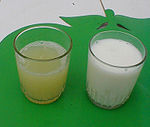Effects of climate change on livestock/ja: Difference between revisions
Created page with "2003年頃、アメリカ合衆国の家禽産業は当時すでに熱ストレスにより年間最大1億6,500万ドルの損失を被っていると推定された。ある論文は、地球温暖化が{{convert|2.5|C-change|F-change}}に達した場合、ブラジルでのブロイラー飼育コストが最も近代化の遅れた農場で35.8%、畜舎技術の中程度レベルを使用する農場で42.3%増加する一方、最先端の冷却技術を持つ農..." Tags: Mobile edit Mobile web edit |
No edit summary Tags: Mobile edit Mobile web edit |
||
| (One intermediate revision by the same user not shown) | |||
| Line 121: | Line 121: | ||
反対に、温暖化が1.5°C(2.7°F)に抑えられた場合、適度に近代化された農場でのコスト増加が最も少なく12.5%となり、次いで最も近代化された農場が19.9%増加し、最も技術が低い農場での増加が最大となる。 | 反対に、温暖化が1.5°C(2.7°F)に抑えられた場合、適度に近代化された農場でのコスト増加が最も少なく12.5%となり、次いで最も近代化された農場が19.9%増加し、最も技術が低い農場での増加が最大となる。 | ||
===トナカイ=== | |||
== | 2010年代半ばまでに、[[:en:Arctic|北極圏]]の[[:en:Indigenous_peoples|先住民]]は、[[reindeer|トナカイ]]の繁殖率が低下し、冬を乗り越えることが少なくなることをすでに観察している。これは、温暖な気温が[[:en:Biting_insect|吸血昆虫]]に利益をもたらし、より激しく永続的な群れの攻撃を引き起こすためである。トナカイはまた、そのような昆虫によって広がる寄生虫により感受性が高まり、北極が温暖化し、[[:en:Invasive_species|侵入種]]にとってよりアクセスしやすくなるにつれて、これまで遭遇したことのない害虫や病原体と接触することが予想される。 | ||
==畜産活動による温室効果ガス排出量== | ==畜産活動による温室効果ガス排出量== | ||
{{excerpt|Greenhouse gas emissions from agriculture#畜産|paragraphs=1-4|file=no}} | {{excerpt|Greenhouse gas emissions from agriculture/ja#畜産|paragraphs=1-4|file=no}} | ||
<span id="See_also"></span> | <span id="See_also"></span> | ||
Latest revision as of 10:57, 19 July 2025


気候変動が畜産業に与える影響には、数多くの相互関連する要素がある。この活動は、温室効果ガス排出により人為的な気候変動に大きく影響を受け、かつその実質的な要因でもある。2011年時点で、約4億人が何らかの形で畜産業に依存して生計を立てている。この分野の商業的価値は1兆ドル近くと推定される。人間による食肉や畜産物の消費を完全に終了することは現在現実的な目標とは考えられていないため、気候変動の影響への包括的な適応では畜産業も考慮しなければならない。
畜産業への観察された悪影響には、最も寒冷な国々を除くすべての地域における熱ストレスの増加が含まれる。これは熱波時の大量の動物死亡と、牛乳などの製品の量や品質の低下、跛行などの症状への脆弱性の増大、さらには繁殖機能の低下などの致死に至らない影響の両方を引き起こす。もう一つの影響は、干ばつやCO2施肥効果の二次的影響による動物用飼料の量や品質の低下に関するものである。飼料栽培の困難により、世界の畜産頭数は今世紀半ばまでに7-10%減少する可能性がある。動物の寄生虫や媒介動物感染症も以前より広範囲に拡散しており、これを示すデータは人間の病原体の拡散への影響を推定するために使用されるものよりも頻繁に優れた品質を示している。
現在家畜を支えている地域の中には、今世紀末の高い温暖化においても「極度の熱ストレス」を回避すると予想される場所もあるが、他の地域では今世紀半ばという早い時期に適さなくなる可能性がある。一般的に、サハラ以南アフリカは、畜産業への気候変動の影響による食料安全保障への打撃に最も脆弱な地域と考えられている。これらの国々の1億8千万人以上が、今世紀半ば頃に牧草地の適性の大幅な低下を経験すると予想されるためである。一方、日本、米国、ヨーロッパ諸国は最も脆弱でないと考えられている。これは、各国への気候の直接的影響の結果であると同時に、人間開発指数やその他の国家回復力の測定値における既存の差異、および国民の食事における牧畜の重要性の大きな違いの産物でもある。
畜産業における気候変動への適応策の提案には、畜舎での冷却システムの改善や動物用飼料の変更などがあるが、これらはしばしば費用がかかり、効果も限定的である。同時に、畜産業は農業からの温室効果ガス排出の大部分を占め、農業の淡水需要の約30%を要求する一方で、世界のカロリー摂取量の18%しか供給していない。動物由来の食品は人間のタンパク質需要の充足においてより大きな役割を果たすが、それでも供給量の39%と少数派であり、残りは作物が提供している。したがって、地球温暖化を1.5 °C (2.7 °F)や2 °C (3.6 °F)などのより低いレベルに制限する計画では、動物由来の食品が世界の食事において現在よりも低い役割を果たすと想定されている。そのため、ネットゼロ移行計画には総畜産頭数の制限(アイルランドなどの国々における既に不釣り合いに大きな家畜数の削減を含む)が含まれ、世界の多くの場所で現在畜産業者に提供されている補助金の段階的廃止を求める声もある。
家畜の熱ストレス
世界規模での増加予測

一般的に、家畜にとって好ましい周囲温度範囲は10 and 30 °C (50 and 86 °F)の間である。気候変動により世界の寒冷地域に住む人間の全体的な温熱快適性が向上すると予想されるのと同様に、それらの地域の家畜も暖かい冬から恩恵を受けるであろう。しかし、世界全体では、夏季の気温上昇やより頻繁で激しい熱波が明らかに負の効果をもたらし、家畜の熱ストレスリスクを大幅に増加させる。最高排出量で最大の温暖化を想定した気候変動シナリオであるSSP5-8.5の下では、「低緯度地域の牛、羊、山羊、豚、家禽は、高温多湿による極度のストレスを年間72-136日多く受ける」ことになる。
カリブ海地域を代表すると考えられるジャマイカでは、採卵鶏を除くすべての家畜動物が現在の気候において既に「極度に深刻な」熱ストレスにさらされており、豚は夏季と初秋の5ヶ月間少なくとも1日1回これにさらされる一方、反芻動物とブロイラーは冬季のみ極度に深刻な熱ストレスへの毎日の曝露を回避している。1.5 °C (2.7 °F)の地球温暖化でも、「極度に深刻な」熱ストレスが反芻動物とブロイラーにとって日常的な出来事になると予測されている。2 °C (3.6 °F)では、それはより長い期間感じられ、広範囲な冷却システムがカリブ海における畜産業に必要となる可能性が高い。2.5 °C (4.5 °F)では、採卵鶏のみが冬季の「極度に深刻な」熱ストレスへの毎日の曝露を避けることになる。
熱ストレスと畜産業の研究は歴史的に牛に焦点を当ててきた。牛はしばしば屋外で飼育されるため、気候の変化に直接さらされるからである。一方、2006年頃でも、世界の豚肉生産の50%強と家禽生産の70%は、完全に閉鎖された建物内で飼育される動物に由来しており、絶対数は豚では3-3.5倍、採卵鶏では2-2.4倍、ブロイラーでは4.4-5倍に増加すると予想されていた。歴史的に、これらの条件下の家畜は、換気システムが気候を制御し余剰熱を除去する断熱された建物に住んでいるため、屋外地域の動物よりも温暖化に対して脆弱でないと考えられていた。しかし、歴史的により涼しい中緯度地域では、夏季でも室内温度が既に屋外温度より高く、増加した暖房がこれらのシステムの仕様を超えるにつれて、閉鎖された動物は屋外で飼育される動物よりも熱に対して脆弱になる。
熱ストレスの健康への影響

家畜動物の体温が正常値より3–4 °C (5.4–7.2 °F)高くなると、これは間もなく「熱射病、熱疲労、熱性失神、熱けいれん、そして最終的には臓器機能不全」につながる。家畜の死亡率は既に年間で最も暑い月や熱波の際に高いことが知られている。例えば、2003年のヨーロッパ熱波では、ブルターニュとペイ・ド・ラ・ロワールのフランス地域だけで数千頭の豚、家禽、ウサギが死亡した。
家畜は熱ストレスによる乳生産量の減少など、複数の致死に至らない影響を受けることもある。気温が30 °C (86 °F)を超えると、牛、羊、山羊、豚、鶏はすべて、その後の気温上昇の度に3-5%少ない飼料を摂取し始める。同時に、これらの動物は呼吸と発汗の速度を増加させ、これらの反応の組み合わせが代謝障害につながる可能性がある。例の一つはケトーシス、すなわち動物の体が自分を維持するために脂肪蓄積を急速に異化することによって引き起こされるケトン体の急速な蓄積である。熱ストレスはまた抗酸化酵素活性の増加を引き起こし、これは酸化物質と抗酸化分子の不均衡、すなわち酸化ストレスとして知られる状態を引き起こす可能性がある。クロムなどの抗酸化物質による飼料補給は酸化ストレスに対処し、それが他の病理学的状態につながることを防ぐのに役立つが、限定的な方法でのみである。
免疫システムもまた、熱ストレスを受けた動物において機能が低下することが知られており、これらの動物をさまざまな感染症により感受性の高い状態にする。同様に、家畜のワクチン接種は熱ストレスに苦しむ際には効果が低い。これまで、熱ストレスは研究者によって一貫性のない定義を用いて推定されており、現在の畜産モデルは実験データとの相関が限定的である。しかし、これを行う最初のモデルは2021年にようやく発表され、それでも体温を系統的に過大評価し、呼吸数を過小評価する傾向がある。
経済的影響と適応

米国だけでも、畜産業における熱ストレスによる経済的損失は2003年に既に16億9千万から23億6千万ドルと評価されており、この幅は当時の適応措置の有効性についてのさまざまな仮定を反映している。それにもかかわらず、一部のレビューでは、米国は畜産業への気候変動の負の影響による食料安全保障への衝撃に最も脆弱でない国と考えられている。畜産業の曝露や社会のその曝露への感受性の点では中程度であるが、GDP と開発状況により世界で最も高い適応能力を持つためである。日本とヨーロッパ諸国も同様の理由で脆弱性が低い。
一方、モンゴルの畜産業の気候変動への曝露はアメリカの畜産業のそれとそれほど変わらないが、モンゴル社会における牧畜の巨大な重要性とその限定的な適応能力により、依然として世界で最も脆弱な国の一つとなっている。サハラ以南アフリカの国々は一般的に高い曝露、低い適応能力、そして社会における畜産業の重要性による高い感受性に苦しんでおり、これらの要因は東アフリカ諸国で特に深刻である。これらの国では、気候変動シナリオに応じて、畜産業地域の4-19%が2070年以降「有意に」多くの「危険な」熱ストレス事象に苦しむと予想されている。最も激しいシナリオであるSSP5-8.5の下では、熱ストレスが既に一部の場所で耐え難いものとなるため、家畜を支えることができる正味の土地面積が2050年までに減少するという高い信頼性がある。
飲料水へのアクセスの増加、屋外で飼育される動物のためのより良い避難所の創設、既存の屋内施設における空気循環の改善など、さまざまな気候変動適応措置が家畜を保護するのに役立つ。特殊な冷却システムの設置は最も資本集約的な介入であるが、将来の温暖化の影響を完全に相殺できる可能性がある。
家畜の給餌の困難
飼料と牧草への気候の影響

家畜は、牧草地から牧草を直接放牧させるか、トウモロコシや大豆などの作物を飼料用に栽培することで給餌される。両方とも極めて重要である。大豆の大部分は飼料用に栽培され、世界の農地の3分の1が牧草に充てられ、約15億頭の牛、2億1千万頭の水牛、12億頭の羊、10億2千万頭の山羊に餌を与えている。どちらかの供給または品質が不十分であると、特に他のストレス要因と組み合わさった場合に家畜の成長と繁殖効率の低下につながり、最悪の場合、飢餓による死亡率の増加を引き起こす可能性がある。これは畜産群が既に持続不可能な規模である場合に特に深刻な問題である。例えば、イランにおける動物飼料要求量の3分の2は、その土地面積の約52%を占める牧草地から来るが、そのうち「中程度」または「貧弱」を上回る牧草品質を持つのは10%のみである。その結果、イランの牧草地は持続可能な能力の2倍以上を支えており、これは1999-2001年の深刻な干ばつで約80万頭の山羊と羊がイランで死亡したような悪天候年における大量死につながる。これは2007-2008年の干ばつ時の数百万頭の動物死亡によって上回られた。
気候変動は家畜動物の食料供給に複数の方法で影響を与える可能性がある。第一に、気温上昇の直接的効果は飼料栽培と牧草地の生産性の両方に影響を与えるが、その方法は様々である。地球規模では、他の条件が等しければ、1 °C (1.8 °F)の温暖化ごとに最も重要な4つの作物の収量が、コメと大豆(主に動物用飼料として栽培される作物)で約3%から、小麦とトウモロコシではそれぞれ最大6%と7.4%まで減少するという確信がある。この世界的な減少は既に暖かい国々における負の影響に支配されており、涼しい国々の農業は温暖化から恩恵を受けると予想されるためである。しかし、これは水利用可能性の変化の影響を含んでおらず、これはアルファルファやトールフェスクなどの牧草種や作物にとって温暖化よりもはるかに重要である可能性がある。一部の研究では、灌漑による高い水利用可能性は作物を気候から「切り離し」、異常気象事象に対してはるかに影響を受けにくくすることを示唆しているが、このアプローチの実現可能性は明らかに地域の全体的な水安全保障によって制限され、特に温暖化が2 or 3 °C (3.6 or 5.4 °F)のレベルに達した場合はそうである。

気候変動は平均的には降水量を増加させるが、地域的変化はより変動が激しく、変動性だけでも「動物の繁殖力、死亡率、群れの回復に悪影響を与え、畜産業者の回復力を低下させる」。 ジンバブエでは、異なる気候変動シナリオ下での降雨の不確実性により、2070年までに20%から100%の農民が負の影響を受ける違いが生じる可能性があり、平均的な畜産収益は潜在的に6%増加する可能性があるが、最大43%も急落する可能性もある。
多くの場所で干ばつの増加が見込まれており、これは作物と牧草地の両方に影響を与える。例えば、地中海地域では、干ばつ年における牧草収量が既に52.8%減少している。干ばつはまた、人間と家畜の両方が使用する淡水源にも影響を与える可能性がある。2019年の中国南西部の干ばつは、100以上の河川と180の貯水池が干上がったため、約82万4千人と56万6千頭の家畜が深刻な水不足を経験する原因となった。この事象は気候変動の結果として1.4-6倍起こりやすくなったと考えられている。山岳地域では、山岳氷河の融解も牧草地に影響を与える可能性があり、最初に土地を洪水させ、その後完全に後退する。
大気中のCO
2と畜産飼料
飼料と牧草の豊富さはCO2施肥効果から大きく恩恵を受け、これは成長を促進し水利用をより効率的にして、特定の場所(すなわち米国の牧草地の多く)で干ばつの影響に対抗する可能性がある。同時に、これは植物の栄養価の低下も引き起こし、一部の牧草草は特定の条件下(すなわち栄養が既に乏しい秋季)で家畜にとって無用になる可能性がある。混合草プレーリーでは、日中1.5 °C (2.7 °F)、夜間3 °C (5.4 °F)の実験的局地温暖化は、同じ実験中にCO
2レベルを600 ppm(2023年の約420 ppmレベルより約50%高い)に増加させることと比較して相対的に軽微な効果を持つ。このような大草原における飼料の全体的な成長の96%は、わずか6種の植物種に由来し、CO
2レベルの増加に主に反応して生産性が38%向上する。しかし、同じ理由で家畜にとっての栄養価も13%低下する。これは、食用となる組織の成長が減少し、消化しにくくなるためである。
温暖化と水不足も栄養価に影響を与え、時には相乗効果をもたらす。例えば、熱帯の重要な飼料植物であるギニアグラスは、水不足(+43%)と温暖化(+25%)の両方に反応して、すでに食べられないリグニンをより多く獲得している。両方のストレス要因に反応した場合のリグニン含有量の増加は最小限(+17%)であるが、高濃度のCO
2は、植物を水ストレスの影響を受けにくくする一方で、その栄養価をさらに低下させる。同様の反応は、熱帯のもう一つの重要な飼料種であるStylosanthes capilataでも観察された。この種は温暖化とともに広く普及する可能性が高いが、栄養価の大幅な損失を避けるためには灌漑が必要となる可能性がある。
家畜の栄養低下による地球規模への影響

総合すると、気候変動によって引き起こされる水不足により、現在の世界の牧草地の約10%が2050年にも脅威にさらされると予想されている。2100年には、現在の作物栽培面積と家畜飼育面積を合わせたものの30%が、最も温暖なシナリオであるSSP5-8.5の下では気候的に不適格となる。これは、低温暖化シナリオであるSSP1-2.6の下での8%とは対照的である。ただし、どちらの数値も生産が他の地域に潜在的にシフトする可能性を考慮していない。2050年までに2 °C (3.6 °F)の温暖化が発生した場合、現在の家畜の7〜10%が主に飼料供給の不足により失われると予測されており、その損失額は100億から130億ドルに上る。
同様に、以前の研究では、2005年から2045年の間に 1.1 °C (2.0 °F)の温暖化(2050年までに2 °C (3.6 °F)に達する速度に匹敵する)が発生した場合、現在の家畜管理の枠組みでは、世界の農業コストが3%(推定1450億ドル)増加し、その影響は純粋な放牧システムに集中するとされている。同時に、混合作物-家畜システムは、2013年時点で世界の牛乳供給の90%以上、反芻動物の肉の80%をすでに生産しているが、これらのシステムが負担するコストは少数にとどまる。そして、すべての純粋な家畜システムを混合作物-家畜システムに切り替えると、世界の農業コストは3%から0.3%に減少し、それらのシステムの半分を切り替えることでコストは0.8%に削減される。この完全な移行は、熱帯地域における将来予測される森林破壊を最大7600万ha削減することにもなる。
病原体と寄生虫
気候による熱ストレスは家畜の全疾病に対する免疫力を直接的に低下させる一方で、気候要因は多くの家畜病原体自体の分布にも影響を与える。例えば、東アフリカにおけるリフトバレー熱の流行は、干ばつ時やエルニーニョ現象発生時により激しくなることが知られている。別の例として、ヨーロッパの蠕虫は現在より高緯度地域まで拡散しており、生存率の向上と繁殖能力(繁殖力)の増加を示している。ヨーロッパにおける家畜疾病と様々な農業介入の詳細な長期記録により、家畜の蠕虫負担増加における気候変動の役割を実証することは、実際には人間に影響を与える疾病への気候変動の影響を帰属させるよりも容易である。

気温上昇は、ブルータング・ウイルスを媒介するヌカカの一種であるCulicoides imicolaにも有利に働く可能性が高い。ライム病やダニ媒介性脳炎などの病原体を媒介するダニのIxodes ricinusは、将来の気候変動の程度に応じて、グレートブリテン島の家畜農場で5-7%より蔓延すると予測されている。
レプトスピラ症に対する気候変動の影響はより複雑である。洪水リスクが増加する地域では流行が悪化する可能性が高いが、気温上昇により東南アジア全体での総発症率は減少すると予測されており、特に高温暖化シナリオ下でその傾向が顕著である。
家畜の種類別
水産養殖
高温暖化下では、2060年以降、貝類水産養殖に適した地域が世界的に減少する。これに先立ち、アジアでは地域的な減少が起こる。養殖魚も他の動物と同様に熱ストレスの影響を受ける可能性があり、タンバキや平鼻ブリームなどの種では、その影響と軽減方法に関する研究がすでに行われている。
ラクダ
ラクダとヤギは、牛よりも干ばつに対する耐性が高い。エチオピア南東部では、一部の牛牧畜民がすでにヤギとラクダへの転換を進めている。
牛

2009年時点で、世界には12億頭の牛が存在し、そのうち約82%が開発途上国にいた。その後も総数は増加し続け、2021年の数字は15.3億頭に達した。2020年時点で、現在の東地中海気候では、牛は適応されていない牛舎内で年間の約半分(159日間)にわたって「軽度の」熱ストレスを経験し、「中等度の」熱ストレスは5月、6月、7月、8月、9月、10月の屋内外で感じられることが判明した。さらに、6月と8月は牛が屋外で「重度の」熱ストレスにさらされる月であり、これは屋内では中等度の熱ストレスまで軽減される。「軽度の」熱ストレスでさえ牛乳の収量を減少させる。スウェーデンでの研究では、平均日気温が20–25 °C (68–77 °F)の場合、1頭当たりの1日の乳量が200 g (0.44 lb)減少し、25–30 °C (77–86 °F)では損失が540 g (1.19 lb)に達することが判明した。
湿潤熱帯気候での研究では、より線形の関係が記述されており、熱ストレスの1単位当たり収量が2.13%減少する。集約農業システムでは、重度の熱ストレス時に1頭当たりの1日の乳量が1.8 kg (4.0 lb)減少する。有機農業システムでは、熱ストレスが乳量に与える影響は限定的であるが、乳「品質」は大幅に低下し、脂肪とタンパク質含量が減少する。中国では、1頭当たりの1日の乳生産量がすでに7月(年間最暑月)に平均より0.7 and 4 kg (1.5 and 8.8 lb)少なく、2070年までには気候変動により最大50%(または7.2 kg (16 lb))減少する可能性がある。一部の研究者は、中国と西アフリカ両地域ですでに記録されている酪農生産の停滞を、持続的な熱ストレス増加に起因するものと示唆している。
熱波も乳量を減少させ、特に熱波が4日以上続く場合に深刻な影響が生じる。この時点で牛の体温調節能力は通常枯渇し、中核体温が上昇し始める。最悪の場合、熱波は大量死を引き起こす可能性がある。1995年7月にはアメリカ合衆国中部の熱波で4,000頭以上の牛が、1999年にはネブラスカ州北東部の熱波で5,000頭以上の牛が死亡した。研究によると、ブラーマン牛とその交雑種は通常のbos taurus品種よりも熱ストレスに対する耐性が高いが、予想される温暖化に追いつくのに十分な速度でさらに耐熱性の高い牛を育種することは不可能と考えられている。さらに、雄雌両方の牛の繁殖が熱ストレスによって阻害される可能性がある。雄では、重度の熱が精子形成と保存された精子の両方に影響を与える可能性がある。精子が再び生存可能になるまでに最大8週間を要することがある。雌では、熱ストレスが黄体を阻害し、卵巣機能と卵母細胞の質を損なうため、受胎率に悪影響を与える。受胎後でも、子宮内膜機能の低下と子宮血流の減少により妊娠が満期まで続かない可能性が高く、胚死亡率の増加と初期胎児死亡を引き起こす。熱ストレスを受けた牛から生まれた子牛は通常、平均以下の体重を示し、代謝の永続的変化により、1歳に達した時点でも体重と身長が平均以下のままである。熱ストレスを受けた牛は、アルブミン分泌の減少と肝臓酵素活性の低下も示している。これは肝臓による脂肪組織の分解促進に起因し、脂肪症を引き起こす。

牛はルーメン性アシドーシスなどの特定の熱ストレスリスクに感受性がある。牛は1日の最暑時間帯に急性熱ストレスを経験すると摂食量が減少し、涼しくなった時に補償するが、この不均衡はすぐにアシドーシスを引き起こし、蹄葉炎につながる可能性がある。さらに、牛が高温に対処しようとする方法の1つがパンティングの頻度増加であり、これにより二酸化炭素濃度が急速に低下し、pHが上昇する。呼吸性アルカローシスを避けるため、牛は排尿を通じて重炭酸塩を排出することを余儀なくされ、これはルーメンの緩衝能力を犠牲にして行われる。これらの病理学的変化の両方が跛行に発展する可能性があり、これは「動物が歩行方法を変える原因となるあらゆる足の異常」と定義される。この影響は重度の熱ストレス曝露後「数週間から数か月」で現れ、痛みを伴う潰瘍や白線病を伴う。もう1つの特定のリスクは乳牛の乳房炎であり、これは通常、牛の乳房への外傷または「乳頭管への細菌侵入に対する免疫応答」によって引き起こされる。高温では牛の好中球機能が阻害され、乳腺が感染により脆弱になる。乳房炎はすでに夏季により蔓延することが知られているため、気候変動の継続によりこれが悪化することが予想される。
乳房炎を引き起こす細菌の媒介者の1つがカリフォラクロバエであり、その数は継続的な温暖化により増加すると予測されており、特にイギリスなどの温帯諸国で顕著である。主に牛に寄生するダニのRhipicephalus microplusは、秋と冬が約2–2.75 °C (3.60–4.95 °F)暖かくなれば、現在温帯の国々で定着する可能性がある。一方、褐色胃虫のOstertagia ostertagiは、温暖化の進行とともに牛での蔓延が大幅に減少すると予測されている。
2017年までに、ネパールの農家は長期化する暑季による損失のため、飼育する牛の数を減らしていることがすでに報告された。ワイオミング州南東部の牛・子牛牧場は、水文循環がより変動的になり牧草の成長に影響を与えるため、将来より大きな損失を被ることが予想される。年間「平均」降水量はそれほど変化しないと予想されるものの、異常に乾燥した年と異常に湿潤した年が増加し、負の影響が正の影響を上回る。乾燥年に対応するためより柔軟性を持たせるために小規模な群れを維持することが適応戦略として提案された。より変動的で予測困難な降水は気候変動の水循環への影響の確立された現象の1つであるため、類似のパターンが後にアメリカ合衆国全体で確立された。

2022年時点で、年間降水量の追加ミリメートル当たり、熱帯諸国では牛肉生産が2.1%増加し、温帯諸国では1.9%減少するが、温暖化の影響ははるかに大きいことが示唆されている。大幅な温暖化と極めて低い適応を想定したSSP3-7.0シナリオ下では、追加の1 °C (1.8 °F)当たり世界の牛肉生産が9.7%減少し、これは主に熱帯および貧困国への影響による。適応措置を講じることができる国では生産量は約4%減少するが、そうでない国では27%減少する。2024年の別の研究では、影響はより軽微であると示唆され、低所得国では追加の1 °C (1.8 °F)当たり1%減少、高所得国では0.2%減少し、SSP3-7.0下で2100年までに世界の牛肉生産が3.2%減少するとされた。同論文は、上位10の牛肉生産国(アルゼンチン、オーストラリア、ブラジル、中国、フランス、インド、メキシコ、ロシア、トルコ、アメリカ)のうち、中国、ロシア、アメリカのみが温暖化進行により全体的な生産増加を見込める一方、残りは減少を経験すると示唆している。他の研究では、気候による降雨パターンの変化によりアルゼンチンの東部と南部が牛牧畜により適するようになる可能性があるが、温暖化の影響を最小限に抑えるためにゼブ品種への転換が必要になると示唆されている。
馬類

2019年時点で、世界には約1,700万頭の馬が存在する。成馬の健康な体温は37.5 and 38.5 °C (99.5 and 101.3 °F)の範囲であり、環境温度が5 and 25 °C (41 and 77 °F)の間である限りこの体温を維持できる。しかし、激しい運動は中核体温を1 °C (1.8 °F)/分上昇させる。これは馬の筋肉で使用されるエネルギーの80%が熱として放出されるためである。ウシや霊長類とともに、馬類は発汗を体温調節の主要な方法として使用する数少ない動物群の1つである。実際、発汗は熱損失の最大70%を占める可能性があり、馬は同程度に激しい身体活動を行う人間の3倍発汗する。人間とは異なり、この汗はエクリン腺ではなくアポクリン腺によって産生される。暑い条件下では、3時間の中等度強度の運動中に馬は30〜35リットルの水分と100グラムのナトリウム、198グラムの塩化物、45グラムのカリウムを失う可能性がある。人間との別の違いは、馬の汗が高張性であり、ラテリンと呼ばれるタンパク質を含んでいることである。これにより汗が体全体により容易に広がり、滴り落ちるのではなく泡立つことが可能になる。これらの適応は、体表面積対質量比が低いために馬が受動的に熱を放射することが困難であることを部分的に補償している。しかし、非常に暑いまたは湿潤な条件への長期間の曝露は、無汗症、熱射病、または脳損傷などの結果を招き、冷水の適用などの措置が講じられなければ死に至る可能性がある。さらに、馬の輸送に関連する事故の約10%が熱ストレスに起因している。これらの問題は将来悪化することが予想される。
アフリカ馬病(AHS)は馬での死亡率が90%近く、ラバでは50%に達するウイルス性疾患である。ヌカカのCulicoides imicolaがAHSの主要な媒介者であり、その拡散は気候変動により恩恵を受けると予想される。オオコウモリ宿主から馬へのヘンドラウイルスのスピルオーバーも増加する可能性が高い。将来の温暖化により宿主の地理的範囲が拡大するためである。「中程度」および高い気候変動シナリオのRCP4.5およびRCP8.5下では、脅威にさらされる馬の数がそれぞれ110,000頭および165,000頭、つまり175%および260%増加すると推定されている。
ヤギと羊

ヤギと羊はしばしば「小反芻動物」として総称され、別々にではなく一緒に研究される傾向がある。特にヤギは最も気候に強靭な家畜の1つとされ、ラクダに次ぐ第2位である。エチオピア南東部では、一部の牛牧畜民がすでにヤギとラクダへの転換を進めている。
それでも、イランでの2007-2008年の干ばつはすでに同国の羊個体数を約400万頭減少させた結果となった。2007年の5,380万頭から2008年の5,000万頭へ、ヤギ個体数は2007年の2,550万頭から2008年の2,230万頭へ減少した。一部の研究者は、気候変動が羊のより暑さと干ばつに適応した品種への遺伝的選択を促進すると予想している。注目すべきことに、暑さに適応した羊は羊毛種と毛種の両方があり得る。毛種が常により熱ストレス耐性が高いという一般的な認識にもかかわらずである。
寄生虫であるHaemonchus contortusとTeladorsagia circumcinctaは、将来の温暖化により冬が穏やかになるにつれて小反芻動物間でより容易に拡散すると予測されている。ただし、一部の地域では夏が彼らの好む温度よりも暑くなることによりこれが相殺される。以前には、亜北極地域の穏やかな気温により、他の2つの寄生虫であるParelaphostrongylus odocoileiとProtostrongylus stilesiが羊内でより長期間繁殖できるようになったことで、同様の効果が観察されている。
豚

豚にとって、熱ストレスは年齢と体重により異なる。平均体重30 kg (66 lb)の幼豚と成長豚は熱ストレスを経験し始める前に24 °C (75 °F)まで耐えることができるが、と畜に適した120 kg (260 lb)程度まで成長・肥育された後は、耐性が20 °C (68 °F)まで低下する。
ある論文は、オーストリアの約1,800頭の成長豚を同時に肥育するために使用される集約農業施設において、1981年から2017年の間に観察された温暖化が相対的年間熱ストレスを年間0.9%から6.4%増加させたであろうと推定した。これは中央ヨーロッパの他の同様の施設の代表例と考えられている。
後続の論文では、いくつかの適応措置の影響が検討された。地中熱交換器の設置が熱ストレス対処において最も効果的な介入であり、90%から100%削減した。他の2つの冷却システムも大幅な効果を示した。湿ったセルロース製の蒸発冷却器パッドは熱ストレスを74%から92%削減したが、必然的に空気を湿らせるため湿球温度ストレスが増加するリスクもあった。このようなパッドと再生熱交換器を組み合わせることでこの問題は解消されたが、コストも増加し、システムの効果は61%から86%に減少した。これら3つの介入はすべて、少なくとも今後30年間にわたって気候変動が熱ストレスに与える将来の影響を完全に緩衝する能力があると考えられたが、設置には相当な初期投資が必要であり、施設の商業的実行可能性への影響は不明である。他の介入は温暖化の影響を完全に緩衝することはできないと考えられたが、比較的安価で単純でもあった。これらには換気能力の倍増、昼間は豚を休ませ涼しい夜間に給餌することが含まれる。このような10時間のシフトには施設が人工照明のみを使用し、主に夜勤作業に切り替える必要がある。同様に、施設当たりの豚の飼育数を減らすことは絶対的に最も単純な介入であるが、効果は最も低く、必然的に収益性を低下させる。
家禽

家禽の熱的快適域は18–25 °C (64–77 °F)の範囲であると考えられている。一部の論文では26–35 °C (79–95 °F)を熱ストレスの「臨界域」として記述しているが、順化により熱帯諸国の鳥類は32 °C (90 °F)まで熱ストレスを経験しないとする報告もある。35 °C (95 °F)および47 °C (117 °F)を超える温度がそれぞれ「上部臨界」および致死域を形成することについては、より広い合意がある。約33 °C (91 °F)の平均日気温はブロイラーと採卵鶏の両方の摂食を妨害し、免疫応答を低下させることが知られており、体重増加/卵生産の減少やサルモネラ感染、フットパッド皮膚炎、髄膜炎の発症率増加などの結果をもたらす。持続的な熱ストレスは組織の酸化ストレスを引き起こし、収穫された白身肉はビタミンE、ルテイン、ゼアキサンチンなどの必須化合物の割合が低下する一方、グルコースとコレステロールが増加する。複数の研究により、クロムの食餌補充がその抗酸化特性により、特に亜鉛やカタバミなどのハーブと組み合わせることで、これらの問題の緩和に役立つことが示されている。レスベラトロールも同じ理由で家禽に投与される人気の抗酸化剤である。補充の効果は限定的であるが、冷却改善や単純に飼育鳥数を減らすなどの介入よりもはるかに安価であるため、依然として人気がある。家禽の熱ストレスと食餌補充に関する文献の大部分はニワトリに焦点を当てているが、ウズラでも同様の知見が見られた。ウズラは熱ストレス下で摂食量と体重増加が減少し、繁殖力が低下し、品質の劣る卵を孵化させるが、ミネラル補充から恩恵を受けるようである。
2003年頃、アメリカ合衆国の家禽産業は当時すでに熱ストレスにより年間最大1億6,500万ドルの損失を被っていると推定された。ある論文は、地球温暖化が2.5 °C (4.5 °F)に達した場合、ブラジルでのブロイラー飼育コストが最も近代化の遅れた農場で35.8%、畜舎技術の中程度レベルを使用する農場で42.3%増加する一方、最先端の冷却技術を持つ農場では最も少ない増加となると推定した。 反対に、温暖化が1.5°C(2.7°F)に抑えられた場合、適度に近代化された農場でのコスト増加が最も少なく12.5%となり、次いで最も近代化された農場が19.9%増加し、最も技術が低い農場での増加が最大となる。
トナカイ
2010年代半ばまでに、北極圏の先住民は、トナカイの繁殖率が低下し、冬を乗り越えることが少なくなることをすでに観察している。これは、温暖な気温が吸血昆虫に利益をもたらし、より激しく永続的な群れの攻撃を引き起こすためである。トナカイはまた、そのような昆虫によって広がる寄生虫により感受性が高まり、北極が温暖化し、侵入種にとってよりアクセスしやすくなるにつれて、これまで遭遇したことのない害虫や病原体と接触することが予想される。
畜産活動による温室効果ガス排出量
畜産は、農業からの温室効果ガス排出量の大部分を占め、農業における淡水需要の約30%を必要とする一方で、世界のカロリー摂取量のわずか18%しか供給していない。動物由来の食品は人間のタンパク質需要を満たす上でより大きな役割を果たすが、それでも供給量の39%と少数派であり、残りは作物が供給している。
気候変動に関する政府間パネルが用いる共有社会経済経路のうち、1.5°C目標を達成する現実的な可能性を提供する唯一の経路はSSP1である。グリーン技術の大規模な導入などの対策と合わせて、この経路は、動物由来の食品が現在と比較して世界の食料において低い役割を果たすことを想定している。この結果、世界各地で畜産農家に現在提供されている補助金の段階的廃止が求められており、ネット・ゼロ移行計画には、アイルランドのような広範な畜産部門を持つ一部の国における既存の家畜数の大幅な削減を含む、家畜総数の制限が盛り込まれている。しかし、肉や動物性食品の人間による消費を完全に終わらせることは、現在、現実的な目標とは見なされていない。したがって、気候変動の影響、特に現在および将来の農業への気候変動の影響への適応に関する包括的な計画は、畜産も考慮に入れなければならない。
畜産活動は、トウモロコシやアルファルファなどの作物が動物の餌として栽培されるため、土地利用への影響にも不釣り合いに寄与している。
2010年、腸内発酵は、世界の全農業活動からの温室効果ガス総排出量の43%を占めた。ライフサイクルアセスメント研究のグローバルメタ分析に基づくと、反芻動物の肉は、他の肉や菜食主義のタンパク源よりも高い炭素換算フットプリントを持つ。羊や山羊などの小型反芻動物は、約4億7500万トンの二酸化炭素換算の温室効果ガス排出に寄与し、これは世界の農業部門排出量の約6.5%を構成する。動物、主に反芻動物によるメタン生産は、世界のメタン生産の推定15〜20%を占める。
関連項目
| この記事は、クリエイティブ・コモンズ・表示・継承ライセンス3.0のもとで公表されたウィキペディアの項目Effects of climate change on livestock(5 July 2025, at 05:20編集記事参照)を翻訳して二次利用しています。 |